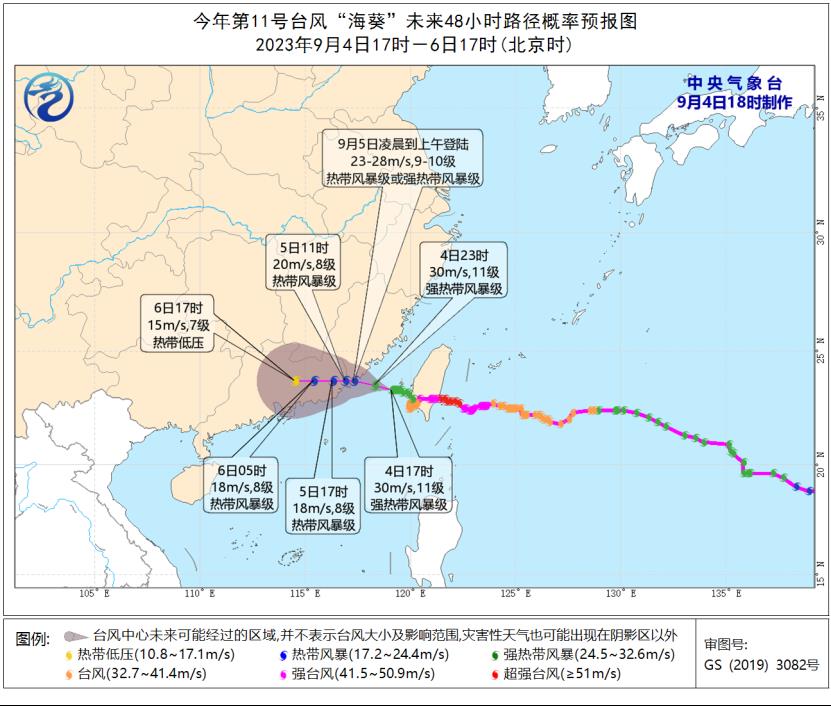CCTV News:The Central Meteorological Observatory continued to issue a yellow typhoon warning at 18: 00 on September 4th. The center of the 11th typhoon "HAIKUI" (a strong tropical storm) this year was located at 5: 00 p.m. today (4th) in the southern Taiwan Province Strait, about 200 kilometers east of the Fujian-Guangdong border, which is 23.3 degrees north latitude and 119.1 degrees east longitude. The maximum wind force near the center is 11 (30m/s). The radius of the tenth wind circle is 20-30 kilometers.
It is estimated that "Anemone" will move to the north-north direction at a speed of 10-15 kilometers per hour, and gradually approach the coastal area along the border between Fujian and Guangdong, and will land in the coastal area from Zhangpu, Fujian to Huilai, Guangdong in the early morning of the 5th (tropical storm level to strong tropical storm level, 23-28 m/s, 9-10), and then move to the west direction after landing, and its intensity will gradually weaken.
Gale forecast:From 20: 00 on September 4 to 20: 00 on September 5, there will be 6-8 winds and 9-10 gusts in the Taiwan Province Strait, the southwest of the East China Sea, the northeast of the South China Sea, and the coastal areas of Fujian, the central and eastern Guangdong, and the western and northern coasts of Taiwan Province Island. The winds in some sea areas or regions will be 9-11 and the gusts will be 12-13.
Precipitation forecast:From 20: 00 on September 4 to 20: 00 on September 5, there were heavy rains in most parts of Fujian, eastern Guangdong, southeastern Jiangxi, southeastern Zhejiang and western Taiwan Province Island. Among them, there were heavy rains in parts of eastern Fujian and southeastern Guangdong, and local heavy rains (250-300 mm). Some of the above areas are accompanied by short-term heavy rainfall (the maximum hourly rainfall is 30-50 mm, and the local area can exceed 70 mm), and there are strong convective weather such as thunderstorms and strong winds.
Defense guide:
1. The government and relevant departments shall, in accordance with their duties, do a good job in typhoon prevention and emergency rescue.
2. Water operations and passing ships in relevant waters should return to Hong Kong to take shelter from the wind, strengthen port facilities, and prevent ships from anchoring, grounding and collision.
3. Stop large-scale indoor and outdoor gatherings and dangerous outdoor operations such as high altitude.
4. Reinforce or dismantle structures that are easy to be blown by the wind. Personnel should not go out at will. They should stay in windproof and safe places as far as possible, so as to ensure that the elderly and children stay in the safest place at home, and the dangerous people will be transferred in time. When the typhoon center passes by, the wind will decrease or stay still for a period of time. Remember that the strong wind will suddenly blow and you should continue to stay in a safe place to avoid the wind.
5. Relevant areas should pay attention to prevent flash floods and geological disasters that may be caused by heavy precipitation.



关于作者